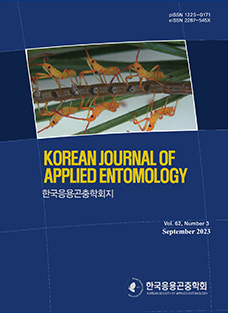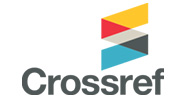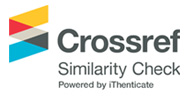The family Rhynchitidae (Coleoptera: Curculionoidea) is widely distributed across most tropical and subtropical regions, comprising approximately 800 species in 50 genera (Legalov, 2005;Sawada, 1993). Among them, the genus Rhynchites, belonging to the tribe Rhynchitini Gistel, 1848, includes species that are recognized as agricultural pests (Legalov and Friedman, 2007).
Globally, 23 species of Rhynchites have been recorded (Alonso-Zarazaga, 2011), with three species - R. foveipennis (Fairmaire, 1888), R. (Epirhynchites) heros (Roelofs, 1874), and R. (R.) bacchus (Linnaeus, 1758) - previously documented in the Korean Peninsula. The first record of R. (E.) heros in South Korea was reported by Muramatsu (1925), followed by Köno (1926), who recorded R. foveipennis, and later, Nagayama and Okamoto (1940), who documented R. (R.) bacchus. Subsequently, Legalov (2007) synonymized R. foveipennis with R. (E.) heros, reducing the number of Rhynchites species recorded in Korea to two. However, the presence of R. (R.) bacchus in Korea remains uncertain (Hong et al., 2001;Hong and Lee, 2014).
In this study, we report the presence of R. (R.) fulgidusFaldermann, 1835, for the first time in Korea, alongside the previously recorded R. (E.) heros. We provide detailed descriptions, diagnostic images, and a taxonomic key for the two Korean Rhynchites species.
Materials and Methods
Specimens used in this study were collected using insect nets and by beating host plants recorded for the genus Rhynchites. In addition to field-collected samples, we examined Rhynchites specimens housed in the collections of the Research Institute of Forest Insect Diversity (RIFID) (Namyangju, Korea), the National Institute of Agricultural Science (NAAS) (Wanju, Korea), the Korea National Arboretum (KNAE) (Pocheon, Korea), and Seoul National University (SNU) (Seoul, Korea).
Morphological characteristics, including male genitalia, were examined under a Leica M205 C stereomicroscope (Leica Microsystems, Solms, Germany) and images were captured with a Dhyana 400D camera (TUCSEN CMOS, Fujian, China) attached to a Leica M205 C. Multi-stacked images were produced using the Delta Multifocus (Ver. 24) program and Helicon Focus ver. 8.2.2. software (HeliconSoft, Ukraine). The final images were edited using Adobe Photoshop 2025 (Adobe Systems, Inc., San Jose, CA, USA). Terminology for male genitalia follows Hamilton (1969).
Collection localities are abbreviated as follows: GG (Gyeonggi Province), SE (Seoul), JB (Jeonbuk Province), and JN (Jeonnam Province).
Results
Family Rhynchitidae Gistel, 1848 (Korean name: Ju-dungi- geo-wi-beol-re-gwa)
Subfamily Rhynchitinae Gistel, 1848 (Korean name: Judung- i-geo-wi-beol-re-a-gwa)
Tribe Rhynchitini Gistel, 1848 (Korean name: Bok-sunga- geo-wi-beol-re-jok)
Genus RhynchitesSchneider, 1791 (Korean name: Boksung- a-geo-wi-beol-re-sok)
Rhynchites (Rhynchites) fulgidusFaldermann, 1835 (Korean name: Ae-bok-sung-a-geo-wi-beol-re) (Fig. 1)
Rhynchites fulgidusFaldermann, 1835: 420.
Rhynchites faldermanniSchoenherr, 1839: 326. [RN]
Rhynchites kozloviSuvorov, 1915: 345.
Rhynchites confragosicollisVoss, 1933: 110.
Rhynchites bacchoidesVoss, 1934: 82.
Rhynchites tygosanensisVoss, 1938: 171.
Redescription. Body length (excl. rostrum) 4.8-6.9 mm.
Male. Body metallic purplish red with greenish lustre; covered erect dark hairs on dorsal surface (Fig. 1). Head cylindrical (Figs 1D, 3A). Eyes slight convex in dorsal view (Figs 1D, 3A). Frons width similar with length of eye, slightly impressed dorsally (Figs 1D, 3A). Antennae inserted at apical four ninths in dorsal view (Figs 1D, 3A); combined length of scape+pedicel little longer than length of 1st flagellum in dorsal view (Fig. 1F). Rostrum 1.6 times as longer than as length of pronotum (mean 2.82/ 1.80 mm) (Fig. 1C); weakly curved downward in lateral view (Fig. 1C); median longitudinal keel in dorsal view (Fig. 1D). Epistoma with one pair of spine (Fig. 1D). Each mandible with three teeth (Fig. 1D). Gena surface yellowish green lustre, smooth with sparse long hairs on anterior half, dark blue median longitudinal suture present (Fig. 1B); thin and dense transverse grooves present in ventral view (Fig. 1B). Pronotum with bottle-like lateral margin (Fig. 1E); apical and basal constriction conspicuous (Fig. 1E); width of posterior region wider than anterior region (Fig. 1E); dark blue lustre median longitudinal line at central region in dorsal view (Fig. 1E). Anterior region of prosternum with one pair of developed smooth elliptic spines anterio-laterally in ventral view (Fig. 1B). Ventral procoxa with light hairs spot (Fig. 1B). Scutellum reverse trapezoid, 2.4 times as width as length (Fig. 1G). Elytra with longitudinal forms of deep punctures and sparsely small punctures (Fig. 1G); parallel-sided in basal one fourth, then slight convex, gradually converging and rounding towards apex in dorsal view (Fig. 1G). Abdominal sternites covered with white hairs, and sunken in lateral view (Fig. 1B,C). Pygidium nearly triangular. Tibiae straight and dilated near apices (Fig. 1A); each with two spur present. Tarsal claw bifid and each claw with one pair of apical tooth.
Male genitalia. Tegmen with rounded apice (Fig. 1H); cap-piece with long hairs apically in dorsal view (Fig. 1H); maximum width of endophallic base 3.1 times as maximum width of cap-piece in ventral view (Fig. 1J). Aedeagus with endophallic strut presented at basal half in dorsal view (Fig. 1H); apical of crescent sclerite moderately sharped in dorsal view (Fig. 1H).
Female. Overall morphology similar with males but it can be distinguished by following characteristics: Head oval; frons 1.2 times as wider than as length of eye in dorsal view (Fig. 3B); antennae inserted at middle region of rostrum in dorsal view (Fig. 3B); rostrum 2.0 times as longer than as length of pronotum (mean 3.12/ 1.54 mm); nearly straight in lateral view. Pronotum apical and basal constriction inconspicuous; width of middle region most wide in dorsal view. Prosternum spine absent. Ventral procoxa with light hairs spot absent. Abdominal sternite II to III with more dense yellowish white long hairs in ventral view; each sternite flattened in lateral view.
Specimens examined. GG: 1♂3♀, Suigen, 15.v.1932, S. Muramathu leg, O1AR00852, O1AR00850, O1AR00856, O1AR00857. (NAAS); 2♂, Gwanggyo, 3.v.1959, Beag leg. (RIFID); 1♂, Suwon, 9.iv.1960, Beag leg. (RIFID); 1♀, Suwon, 19.vii.1965, Beag leg. (RIFID); 1♂, Gwangleung, 6.x.1973, Jung yeong lyu leg. (RIFID); 1♀, Mt. Wang-bang, 17.vi.1977, K. J. Won leg, KNAE375025.; 1♂, Anyang, 25.v.1986, Lee G.J leg. (RIFID); 1♀, Mu-an, 14.v.1996, J. Y. Choi leg. (RIFID); 1♂, 332-4, Sucheong-dong, Osan-si, GG, 1.vi.2015, Hwaseop Song leg. (SNU). SE: 1♀, SNU, Kwanak-ro, Kwanak-gu, Seoul, 14.v.2015, Minsuk Oh leg. (SNU); SJ; 1♂1♀, Sejong, 14.v.2023, Sung-Il Cho leg. (WKU). JB: 6♂4♀, Imsil-gun, Deogchi-myeon, 11.v.2024, 35˚29’22”N 127˚11’54”E, Hojin Jeon leg. (WKU).
Distribution. Korea (GG, JB, SE, SJ) (new record), China, Mongolia, Russia (Legalov, 2007).
Ecology. The first author collected six males and four females from Prunus davidiana (Rosaceae) on May 11, 2024.
Rhynchites (Epirhynchites) herosRoleofs, 1874 (Korean name: Bok-sung-a-geo-wi-beol-re) (Fig. 2)
Rhynchites herosRoelofs, 1874: 141.
Rhynchites sumptuosusRoelofs, 1875: cxxxii.
Rhynchites foveipennisFairmaire, 1888: 136.
Rhynchites koreanusKöno, 1926: 89.
Rhynchites mongolicusVoss, 1930: 78.
Rhynchites ignitusVoss, 1953: 43.
Redescription. Body length (excl. rostrum) 7.8-9.3 mm.
Male. Body metallic purple to blue and covered with erect dark hairs on dorsal surface (Fig. 2). Head cylindrical (Fig. 2D). Eyes convex in dorsal view (Figs 2D, 3C). Frons 1.2 times as wider than as length of eye in dorsal view (Figs 2D, 3C). Antennae inserted at apical one third in dorsal view (Figs 2D, 3C); combined length of scape+pedicel shorter than length of 1st flagellum in dorsal view (Fig. 2F). Rostrum 1.6 times as longer than as length of pronotum (mean 4.16/2.45 mm) (Fig. 2C); slightly curved downward and suddenly curved downward at insertion of antenna in lateral view (Fig. 2C); median longitudinal keel in dorsal view (Fig. 2D). Epistoma with one pair of spine (Fig. 2D). Each mandible with three teeth. Gena surface dark green lustre, smooth with sparse short and thin hairs on anterior half, dark blue median longitudinal suture present (Fig. 2B); thin and dense transverse grooves present in ventral view (Fig. 2B). Pronotum with bottle-like lateral margin (Fig. 2E); apical and basal constriction conspicuous (Fig. 2E); width of posterior region wider than anterior region (Fig. 2E); densely punctate with sub-erect dark hairs; dark blue lustre median longitudinal line, one pair of oblique impressions at central region in dorsal view (Fig. 2E). Anterior region of prosternum with one pair of developed smooth, short conical spines anterio-laterally in ventral view (Fig. 2B). Ventral procoxa with light hairs spot (Fig. 2B). Scutellum reverse trapezoid, 2.3 times as width as long (Fig. 2G). Elytra with longitudinal forms of oval deep punctures and sparsely small punctures (Fig. 2G); parallel-sided in basal half, then gradually converging and rounding towards apex in dorsal view (Fig. 2G). Abdominal sternites covered with white hairs in ventral view, and sunken in lateral view (Fig. 2B, C). Pygidium nearly triangular. Tibiae straight and dilated near apices (Fig. 2A); each fore tibia with one spur and mid- and hind tibia with two spurs. Tarsal claw bifid and each claw with one pair of apical tooth.
Male genitalia. Tegmen with apice truncated; cap-piece with long hairs apically in dorsal view (Fig. 2H); maximum width of endophallic base 2.2 times as maximum width of cap-piece in ventral view (Fig. 2J). Aedeagus with endophallic strut absent in dorsal view (Fig. 2H); apical of crescent sclerite rounded apically in dorsal view (Fig. 2H).
Female. Overall morphology similar with males but it can be distinguished by following characteristics: Head oval; frons 1.7 times as wider than as length of eye in dorsal view (Fig. 3D); more convex than male in lateral view; antennae inserted at middle region of rostrum (Fig. 3D); combined length of scape+ pedicel similar with length of 1st flagellum in dorsal view; rostrum 1.7 times as longer than as length of pronotum (mean 3.97/ 2.32 mm); nearly straight in lateral view. Pronotum apical and basal constriction inconspicuous; width of middle region most wide in dorsal view. Prosternum spine absent. Ventral procoxa with light hairs spot absent. Abdominal sternites flattened in lateral view.
Specimens Examined. GG: 3♂, Suigen, 5.v.1922, S. Muramathu leg, O1AR00885, O1AR00902, O1AR00904. (NAAS); 1♂, Suigen, 1.vi.1922, S. Muramatsu leg, O1AR00908. (NAAS); 1♀, Suigen, 25.iv.1922, T. Kurisue leg, O1AR00914. (NAAS); 1♀, Suigen, 8.vi.1923, M. Ochi leg, O1AR00918. (NAAS); 1 ♀, Suigen, 9.vi.1923, M. Ochi leg, O1AR00919. (NAAS). JN: 1♂, Dabgog, JN, 11.viii.1993, I. K. Lee leg. (SNU).
Distribution. Korea (GG, JN), China, Japan, Mongolia, Russia (Legalov, 2007).
A key to Korean Rhynchites species
-
- Flagellum 6 more than 1.5 times as wide in males and females; antennae inserted at apical one third of rostrum, cap-piece narrowly rounded apically in male ·················· ············································ R. (R.) fulgidus Faldermann
-
- Flagellum 6 less than 1.5 times as wide in males and females; antennae inserted at apical four ninth of rostrum, cap-piece truncated apically in male ······························· ······················································ R. (E.) heros Roelofs
Discussion
Rhynchites (Epirhynchites) heros (Roelofs) was the first species of the genus recorded in Korea (Muramatsu, 1925), followed by R. foveipennis (Fairmaire), reported by Köno (1926). Later, Nagayama and Okamoto (1940) noted that the Korean R. foveipennis recorded by Köno (1926) was a misidentification of Rhynchites (Rhynchites) bacchus Linnaeus. Subsequently, Legalov (2007) synonymized R. foveipennis with R. (E.) heros, reducing the number of recognized Rhynchites species in Korea to two.
However, the validity of R. (R.) bacchus as a Korean species has been questioned (Hong et al., 2001;Hong and Lee, 2014). To clarify its identity, the second author (Dr. S. Park) examined voucher specimens of R. (R.) bacchus Linnaeus housed at the Natural History Museum (London, U.K.) (Fig. 3). Our findings indicate that the specimens previously identified as R. (R.) bacchus in Korea actually belong to R. (R.) fulgidus Faldermann.
Morphological comparisons further support this conclusion. The elytral strioles of R. (E.) heros are large and rough, whereas those of R. (R.) fulgidus and R. (R.) bacchus are smaller but distinct. In males, the antennae of R. (E.) heros are inserted at the anterior part of the rostrum, while in R. (R.) fulgidus and R. (R.) bacchus, they are positioned near the middle. Additionally, the rostrum of R. (R.) fulgidus is significantly more slender than that of R. (R.) bacchus. The first and second antennal flagella of R. (R.) fulgidus are long and slender, whereas those of R. (R.) bacchus are thick and short (Fig. 4).
Rhynchites (R.) fulgidus Faldermann is classified as a "Regulated Pest" under the Plant Protection Act (Korean Law Information Center). However, after examining numerous historical and recently collected specimens from various depositories (RIFID, SNU, KNAE, NAAS), we conclude that this species has not recently invaded Korea but is native to the Korean Peninsula.











 KSAE
KSAE





